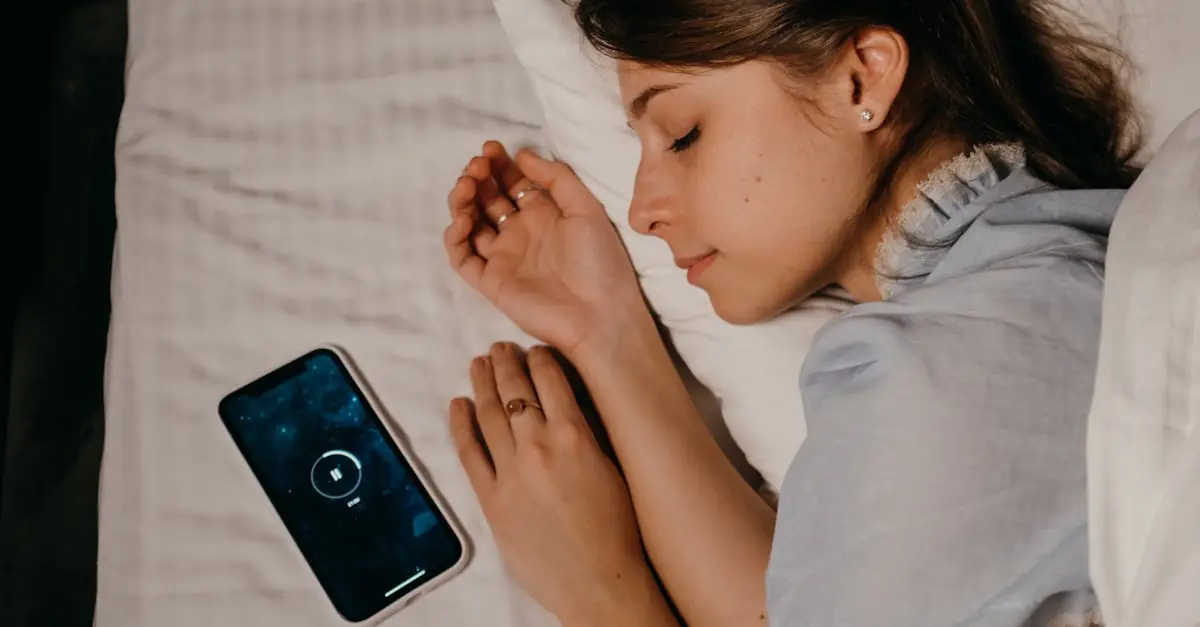Table of Contents
ToggleIn a world where sleep often takes a backseat to late-night scrolling and caffeine-fueled work marathons, sleep enhancement apps have emerged as the superheroes of slumber. These digital dreamweavers promise to transform restless nights into peaceful journeys through the land of nod. With just a tap, users can access soothing sounds, guided meditations, and personalized sleep plans that even the sleep-deprived can’t resist.
Imagine trading in those sheep for a calming ocean breeze or a gentle rainstorm right from your smartphone. Whether you’re a chronic insomniac or just someone who occasionally battles the bedtime blues, these apps are here to help. They’re not just tools; they’re your ticket to waking up refreshed and ready to conquer the day—without the need for a triple espresso. So, let’s dive into the world of sleep enhancement apps and discover how they can help turn your snooze button into your best friend.
Overview of Sleep Enhancement Apps
Sleep enhancement apps have gained popularity as effective tools for improving sleep quality. Users find these applications beneficial in creating personalized sleep routines. Features often include soothing sounds, guided meditations, and sleep tracking capabilities.
Many apps offer soundscapes that help mask disruptive noises, creating a peaceful sleep environment. Guided meditation sessions promote relaxation, addressing anxiety that often interferes with falling asleep. Sleep tracking tools monitor patterns, providing insights into sleep quality and duration.
Some of the most popular apps include Calm, Headspace, and Sleep Cycle. Calm focuses on meditation and sleep stories, while Headspace offers a range of mindfulness techniques. Sleep Cycle utilizes sleep data to wake users at their lightest sleep stage, enhancing wakefulness.
Users can experience tailored sleep solutions with in-app assessments. Personalized sleep plans adapt to individual needs based on user behavior and preferences. Through regular use, many individuals report significant improvements in their sleep cycles.
Data indicates that approximately 60 million adults in the U.S. experience sleep disorders, emphasizing the relevance of these apps. The availability and wide array of features make sleep enhancement apps a viable choice for anyone seeking better sleep quality.
Crafting a suitable environment using an app leads to more restful nights. Consequently, these digital resources offer promising alternatives to traditional sleep aids. Exploring various apps allows users to find the right fit for their unique sleep challenges.
Types of Sleep Enhancement Apps
Numerous types of sleep enhancement apps cater to various needs. Users can choose from an array of features designed to improve their sleep experience.
Sleep Tracking Apps
Sleep tracking apps monitor sleep patterns and provide insights into sleep quality. These apps analyze data like sleep duration and cycles, helping users identify trends. Notable examples include Sleep Cycle and Pillow, as they wake users during lighter sleep stages for a more refreshed feeling. Users can gain a clearer understanding of their sleep habits through personalized reports. By utilizing such apps, individuals can implement effective strategies for enhancing their sleep quality.
Guided Sleep Meditation Apps
Guided sleep meditation apps facilitate relaxation through structured meditations and soothing narratives. Apps like Calm and Headspace offer a variety of sleep-focused meditations that can lead to restful nights. With options ranging from short sessions to longer narratives, users can find guidance that suits their preferences. Many of these apps also provide breathing exercises, enabling deeper relaxation before bed. Establishing a nightly routine with these apps can significantly improve users’ overall sleep experience.
White Noise and Ambient Sound Apps
White noise and ambient sound apps create a calming auditory environment to promote sleep. These apps generate sounds like rainfall, ocean waves, or soft music, which can drown out disruptive noises. Popular options include myNoise and Relax Melodies, both of which allow users to customize soundscapes. The right background noise facilitates relaxation, making it easier to drift off to sleep. Incorporating these apps into a bedtime routine enhances the overall sleep environment for many users.
Features to Consider
When exploring sleep enhancement apps, several key features significantly influence user experience and effectiveness.
User Interface and Design
An intuitive user interface enhances accessibility. Clean layouts and easy navigation allow users to find features quickly. Bright colors or calming tones contribute to a soothing environment. Visual appeal often attracts users, prompting them to use the app consistently. Responsiveness of the design also matters, as it helps users interact with the app without frustration.
Customization Options
Robust customization options enable users to tailor their sleep experience. Setting personalized soundscapes or meditation lengths enhances relaxation. Users appreciate being able to adjust reminders and notifications according to their schedules. Adaptive algorithms that suggest routines based on individual habits further customize the experience. Ultimately, these options create a more engaging and effective sleep aid.
Compatibility with Devices
Compatibility with various devices increases app accessibility. Users benefit from apps that work seamlessly on smartphones, tablets, and smartwatches. Integration with wearable technology allows for accurate sleep tracking and notifications. Furthermore, compatibility with other platforms enhances user experience, enabling synchronization across devices. This versatility ensures users can monitor and improve their sleep, regardless of their preferred technology.
Benefits of Using Sleep Enhancement Apps
Sleep enhancement apps provide numerous advantages for users seeking better sleep quality. Increased relaxation techniques promote a calmer state before bed, allowing for a smoother transition to sleep. Users often experience improved sleep schedules as these apps guide them to establish consistent bedtime habits.
Access to sleep analysis tools offers insights into individual sleep patterns, helping users identify factors affecting their rest. With data-driven feedback, people gain a thorough understanding of their sleep quality, enhancing their ability to make informed changes.
Incorporating soothing sounds and guided meditations creates an optimal sleep environment. Many people report falling asleep faster when listening to calming sounds, which help mask disruptive noises. Users also find that mindfulness techniques reduce stress, aiding in relaxation.
Customization options allow individuals to tailor their experience based on personal preferences. By selecting specific sounds or meditations, users personalize their sleep routines, making improvements more effective. Adaptive features ensure that recommendations evolve based on ongoing assessments.
A sense of community exists within many sleep enhancement apps, fostering connections between users. Sharing experiences or tips can motivate individuals, enhancing accountability for their sleep goals. This sense of belonging promotes healthy habits and encourages consistent usage.
Finally, sleep enhancement apps often promote better overall health. Improved sleep quality contributes to increased focus, productivity, and emotional well-being. Facilitating better rest empowers users to tackle daily challenges more effectively, leading to a more fulfilling lifestyle.
Potential Drawbacks of Sleep Enhancement Apps
Sleep enhancement apps may present several drawbacks that users should consider. Privacy concerns often arise with data-driven apps that track sleep patterns. Many apps collect personal information, and some users worry about how this data is stored and shared.
Dependence can develop as users rely on these apps for sleep. Without access to their favored apps, individuals may find it challenging to fall asleep independently, potentially inhibiting natural sleep habits. Additionally, some apps require ongoing subscriptions, which can incur significant costs over time.
Not all apps deliver the same effectiveness for every user. Results can vary greatly based on individual preferences and sleep needs. Users may discover that certain techniques or features resonate less, leading to frustration or minimal improvements.
Screen time before bed can create problems as well. Exposure to blue light emitted from screens might hinder melatonin production, ultimately affecting sleep quality. Users who engage with apps right before sleep might inadvertently worsen their sleep issues.
Technical issues also pose a risk. App crashes or connectivity problems can disrupt intended sleep sessions. Areas with poor internet connectivity may experience reduced app functionality, limiting the guidances available during critical relaxation sessions.
While sleep enhancement apps offer innovative solutions, potential drawbacks merit consideration. Users must weigh these limitations against the benefits to determine the most viable option for improving their sleep quality.
Sleep enhancement apps have emerged as valuable tools for improving sleep quality in today’s fast-paced world. By offering personalized features and innovative solutions, these apps cater to a wide range of sleep challenges. Users can explore various types of apps to find the best fit for their needs, whether it’s tracking sleep patterns or providing guided meditations.
While there are potential drawbacks to consider, the benefits often outweigh the risks. With the right app, individuals can create a more restful sleep environment and develop healthier sleep habits. As technology continues to evolve, these digital resources will likely play an increasingly important role in promoting better sleep and overall well-being.








